
Lepidoptera or lepidopterans is an order of winged insects that includes butterflies and moths. About 180,000 species of the Lepidoptera have been described, representing 10% of the total described species of living organisms, making it the second largest insect order with 126 families and 46 superfamilies, and one of the most widespread and widely recognizable insect orders in the world.

Moths are a group of insects that includes all members of the order Lepidoptera that are not butterflies. They were previously classified as suborder Heterocera, but the group is paraphyletic with respect to butterflies and neither subordinate taxon is used in modern classifications. Moths make up the vast majority of the order. There are approximately 160,000 species of moth, many of which have yet to be described. Most species of moth are nocturnal, although there are also crepuscular and diurnal species.

The North Downs are a ridge of chalk hills in south east England that stretch from Farnham in Surrey to the White Cliffs of Dover in Kent. Much of the North Downs comprises two Areas of Outstanding Natural Beauty (AONBs): the Surrey Hills and the Kent Downs. The North Downs Way National Trail runs along the North Downs from Farnham to Dover.
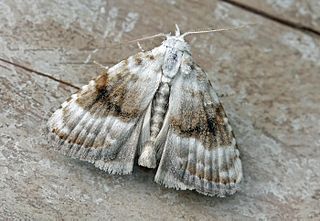
Meganola albula, the Kent black arches, is a moth of the family Nolidae. The species was first described by Michael Denis and Ignaz Schiffermüller in 1775. It is found in the Palearctic realm.

Euplagia quadripunctaria, the Jersey tiger, or Spanish flag, is a diurnal moth of the family Erebidae. The species was first described by Nikolaus Poda von Neuhaus in 1761. The adult wingspan is 52–65 millimetres (2.0–2.6 in), and they fly from July to September, depending on the location. They tend to fly close to Eupatorium cannabinum.
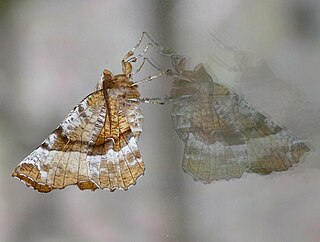
Selenia kentaria, commonly known as Kent's thorn or Kent's geometer, is a moth of the family Geometridae. The species was first described by Augustus Radcliffe Grote and Coleman Townsend Robinson in 1867. It is found in eastern and central North America.
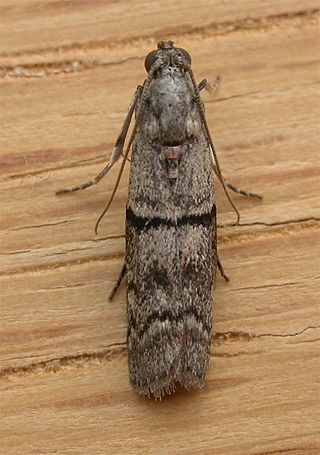
The Phycitini are a tribe of moths of the family Pyralidae.

Vitula is a genus of snout moths. It was described by Émile Louis Ragonot in 1887.
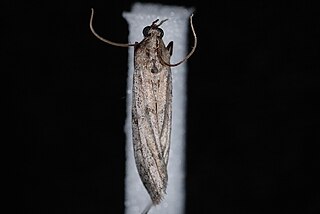
Vitula edmandsii, the American wax moth, dried-fruit moth or dried fruit moth, is a species of snout moth in the genus Vitula. It shares its common name with Cadra calidella, another dried fruit moth. It was described by Packard in 1865. It is found in Germany, Denmark and Fennoscandia, as well Great Britain and eastern North America. The beehive honey moth, which is found in western North America, is either treated as a full species or as a subspecies of Vitula edmandsii.
Vitula setonella is a species of snout moth in the genus Vitula. It was described by James Halliday McDunnough in 1927. It is found in British Columbia, Utah, California and Arizona.
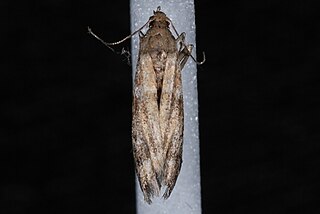
Vitula broweri, or Brower's vitula moth, is a species of snout moth in the genus Vitula. It was described by Carl Heinrich in 1956. It is found in much of North America, including British Columbia, Manitoba, Maryland, Massachusetts, Ohio, Oklahoma, Ontario, Tennessee, West Virginia and Wisconsin.
Vitula coconinoana is a species of snout moth. It was described by Herbert H. Neunzig in 1990. It has been recorded in North America from Alberta and Arizona.
Vitula divergens is a species of snout moth. It was described by Harrison Gray Dyar Jr. in 1914. It is found in Panama.
Vitula aegerella is a species of snout moth. It was described by Herbert H. Neunzig in 1990. It is found in the US state of Arizona.
Vitula insula is a species of snout moth. It was described by Herbert H. Neunzig in 1990. It is found in the US state of California.
Vitula lugubrella is a species of snout moth in the genus Vitula. It was described by Émile Louis Ragonot in 1887. It is found in North America, including California.
Vitula pinei is a species of snout moth in the genus Vitula. It was described by Carl Heinrich in 1956. It is found in the US states of California, Arizona, Texas and Utah.
Vitula inanimella is a species of snout moth in the genus Vitula. It was described by Harrison Gray Dyar Jr. in 1919. It is found in Mexico and Guatemala.
Vitula laura is a species of snout moth in the genus Vitula. It was described by Harrison Gray Dyar Jr. in 1919. It is found in Guatemala.










